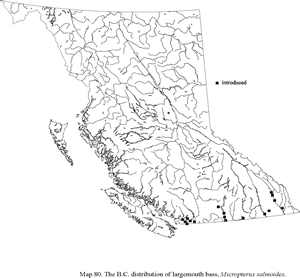Dorsal spines (total): 10; Dorsal soft rays (total): 11 - 14; Anal spines: 3; Anal soft rays: 10 - 12; Vertebrae: 30 - 32. Mouth large; maxillary extending beyond the eye. Pelvic fins not joined by a membrane. Green to olive dorsally, milk-white to yellow ventrally, with a black band running from the operculum to the base of the caudal fin. Caudal fin rounded. Caudal fin with 17 rays (Ref. 2196).
Source: FishBase. Page, L.M. and B.M. Burr 1991 A field guide to freshwater fishes of North America north of Mexico. Houghton Mifflin Company, Boston. 432 p.
